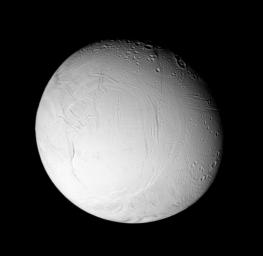
|
Fresh Features on Enceladus (Monochrome)
- Click the image above for a larger view
- Full-Res JPEG (750 x 729) (34.5 kB)
- Full-Res TIFF (750 x 729) (547.6 kB)
Caption:
Wrinkles and cracks have reworked the surface of Enceladus, perhaps due to the influence of tidal stresses. The monochrome view also makes it clear that certain geological provinces on the moon have been altered by the activity, erasing ancient craters, while other places have retained much of the cratering record.
See PIA07708 for a false-color version of this view.
Terrain on the trailing hemisphere of Enceladus (505 kilometers, or 314 miles across) is seen here. North is up.
The image was taken using a near infrared spectral filter sensitive to wavelengths of light centered at 752 nanometers. The view was obtained using the Cassini spacecraft narrow-angle camera on Jan. 17, 2006 at a distance of approximately 153,000 kilometers (95,000 miles) from Enceladus and at a Sun-Enceladus-spacecraft, or phase angle, of 29 degrees. Image scale is 912 meters (2,994 feet) per pixel.
Background Info:
The Cassini-Huygens mission is a cooperative project of NASA, the European Space Agency and the Italian Space Agency. The Jet Propulsion Laboratory, a division of the California Institute of Technology in Pasadena, manages the mission for NASA's Science Mission Directorate, Washington, D.C. The Cassini orbiter and its two onboard cameras were designed, developed and assembled at JPL. The imaging operations center is based at the Space Science Institute in Boulder, Colo.
For more information about the Cassini-Huygens mission visit http://saturn.jpl.nasa.gov/home/index.cfm . The Cassini imaging team homepage is at http://ciclops.org .
Cataloging Keywords:
| Name | Value | Additional Values |
|---|---|---|
| Target | Enceladus | |
| System | Saturn | |
| Target Type | Satellite | |
| Mission | Cassini-Huygens | |
| Instrument Host | Cassini Orbiter | |
| Host Type | Orbiter | |
| Instrument | Imaging Science Subsystem (ISS) | |
| Detector | Narrow Angle Camera | |
| Extra Keywords | Crater, Grayscale, Infrared, Visual | |
| Acquisition Date | ||
| Release Date | 2006-02-22 | |
| Date in Caption | 2006-01-17 | |
| Image Credit | NASA/JPL/Space Science Institute | |
| Source | photojournal.jpl.nasa.gov/catalog/PIA07709 | |
| Identifier | PIA07709 | |
